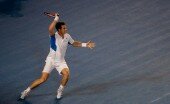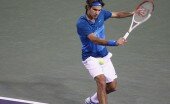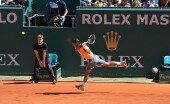Five things we learned from Roland Garros
Written by Suhrith // June 7, 2011 // Sport // 11 Comments
1. Roger Federer isn’t yet the greatest of all time:
It is nigh on impossible, I believe to make such an assertion in the first place, and in any event Roger Federer’s record against his chief rival, Rafael Nadal ridicules the suggestion. Of course, Federer is statistically the most successful player in Grand Slam tennis history and he wins by playing in a beautiful, easy style. But Nadal has beaten Federer in 17 of their 25 meetings and in 6 of their 8 contests in Grand Slam finals, putting in rich perspective the fallacy in the argument that Federer is the greatest to have wielded a tennis racquet. No doubt, the Swiss belongs in a pantheon that comprises Bjorn Borg, Pete Sampras, Rod Laver and a few others, but to place him indisputably on top of that list is incorrect, to put it mildly.
2. Nadal’s greatest attribute is his ability to win ugly:
I doubt anyone in the history of the sport has been better than Nadal at winning ugly when required to. This is not to suggest that he cannot win beautifully. Indeed when he is at the top of his game, he is as imperious and as handsome a sight as any other. But even when his game isn’t quite up to scratch, Nadal finds a way through irrespective of the demands of his opponent. On Sunday, Federer was at his mesmerizing best in the first set, seemingly killing Nadal with his sinuous, entrancing grace. Down 2-5, the Spaniard had no right to win the set. He was being enthralled into submission. His groundstrokes were meek, his serves were devoid of punch and he looked a shadow of his usually commanding self. Yet, he came-back to win five games in a row to seal the set and effectively kill any hopes of an upset. Not, though, by finding rhythm in his strokes, but by chasing Federer’s shots down with vigour and vitality and stunning the Swiss into compliance through sheer force of will. Before the Djokovic-Federer semifinal, Nadal commented that the match pitted the “best player at the moment against the best player in history”. Where does it leave him then?
3. All-court players are on the rise:
Rarely in Grand Slams do the top four seeds of the men’s game qualify for the semi-finals. This is rarer still at the French Open, for historically many top players have been ill suited to the red clay in Paris. In recent times, though, players have become increasingly more comfortable on all surfaces. I would imagine that the causes for the phenomenon are essentially two-fold: (a) The surfaces at all four of the Grand Slams are coming closer to each other in terms of their overall play. The clay at Paris has become quicker, the grass at Wimbledon slower and the hard courts in Melbourne Park and Flushing Meadows have gravitated towards each other in terms of their constituents. (b) Concomitantly, players no longer shape their styles to suit a certain surface. Romantics crave for the return of the serve-and-volley game, but when one can win Wimbledon by playing from the baseline in a style that will also predominantly suit the clay at Roland Garros, players would be foolish to model themselves on an Edberg or a Sampras. Equally, though, the clay-court specialist, the slugger from the baseline, is also no longer in abundant evidence. The top players are capable of winning any of the four Grand Slams by merely tweaking certain aspects of their game without altering its foundations.
4. Brit when he wins; Scot when he loses:
Had he been competing in any other era, Andy Murray would, perhaps, have been a Grand Slam champion by now. That he is fourth in the list of a truly outstanding quartet is no disgrace for his talents are nonetheless deserving of a Grand Slam title. Fred Perry was the last Briton to win a Slam (the 1936 US Open) and the pressures of this void had weighed heavily, first, on Tim Henman – a player infinitely less talented than Murray – and now weigh heavily on the Scotsman who has reached three Grand Slam finals without success. In evidence, though, at Roland Garros was an attribute, which should continue to brighten the hopes of the British. In his third round match against Michael Berrer, Murray turned his ankle, injuring it critically, and yet soldiered to victory in four sets. A lesser man would have withdrawn from the match and the tournament. Murray, however, battled hard, defeated Victor Troicki in five grueling sets in the fourth round before cruising past Juan Ignacio Chela to set up a duel with Rafael Nadal. Against the Spaniard, admittedly Murray came a cropper in three straight sets, but for much of the match, Murray was the better player. It would be pure conjecture to suggest that he may well have beaten Nadal, if not for his weak ankle, but in fighting the Spaniard and running him close – which he certainly did in spite of the suggestions of the scoreboard – Murray showcased that he has the requisite skills to, one day, win a Grand Slam.
5. The Women’s game is in a bit of a shambles:
We all love an underdog success, but in women’s tennis, the world number 1 is often the underdog. Caroline Wozniacki, the twenty-year-old Dane, has held the position for 32 weeks now, and yet hasn’t a single Grand Slam title to show. In fact, she has reached only a solitary final, the 2009 US Open. This of course raises questions on the ranking system, as it rightly should. But the malaise in the women’s tour runs deeper. Serena Williams, unquestionably the finest player produced since the days of Steffi Graf and Monica Seles, hasn’t played a tournament since Wimbledon last year owing to injury and even when fit restricts her appearances to Grand Slams and a few other high-profile tournaments. The other top players in recent times, Wozniacki, Ana Ivanovic and Jelena Jankovic fell early at Roland Garros as they have tended to do in recent times. So too did Kim Clijsters, Victoria Azarenka and Vera Zvonareva, the more consistent of the higher ranked players, leaving the no. 6 seed, Li Na and the No. 8 seed, Francesca Schiavone to contest the final. This preponderance of ‘upsets’ though must not be confused with depth of talent. In the absence of Serena Williams, and since the retirement of Justine Henin, the women’s game not only lacks a predominant power-base, but is also devoid of quality at the top. ‘Quality’ though must not be interpreted as mere physical and technical abilities. The likes of Wozniacki and Azarenka, perhaps, have the requisite technical attributes for Grand Slam success, but as history has showed us, sustained success at the level takes more than just that. The fact that the draw at Roland Garros was wider than ever before wasn’t indicative of depth but the lack of a single outstanding candidate.
(Inspired by The Guardian’s Five Things We Learned series)





11 Comments on "Five things we learned from Roland Garros"
No American player in top 10 for the first time??? Isn’t that more important than Andy Murray???
I don’t think so. Murray is one of the top players in the world at the moment and I made the point not because he is British but because he has the potential to win a Grand Slam. I brought in Fred Perry, etc., to merely show the pressure that Murray is put under by the British press.
America is obviously going through a trough in terms of producing quality tennis players. But that is a point more specific to tennis in general as opposed to being a take-away from Roland Garros, where no American has won, or for that matter come close to winning, since Agassi in 1999.
Hi Suhrith. Enjoyed the article but I’m not sure I follow your thinking on the comment about Federer not being the greatest of all time. If Federer’s record against Nadal is poor, then why does it imply that Sampras and Laver are better players than Federer? If anything, it should imply that Rafa is making a good case to have his own name elevated into the all-time greats pantheon.
Hi Anisha,
Thanks for your comment. I think it’s, per se, not possible to compare across eras. Statistically, Federer in Grand Slams, at least, is above everyone else, but it is impossible to say without doubt that he was better than Laver, Sampras, etc. And the fact that he is, perhaps, not even the best of his own generation only makes the argument that he is the greatest of all time that much more dubious. Like you say the fact that he is not better than Laver or Sampras may not flow from his record against Nadal, but at least those two stood mostly peerless in their own eras.
And on the question of Nadal’s place own place in the pantheon, like you say this victory only fortifies it. There is no question that he is up with there with the greatest.
Disagree completely on the Federer-Nadal comparison. Two major correctives are needed to better appreciate the 17-8 H2H: 1. An enormous number of their matches have been played on clay on which Nadal is probably the greatest of all time; 2. Age difference – Federer is a good 5 years older than Nadal and his peak was in the period 2004-07, whereas Nadal’s is more recent (2008-10). Unfortunately Nadal did not even reach the latter stages of most events in the period of Federer’s domination or the stats could have been very different.
Consequently, in non-clay events from 2004-2007, the record was 5-2 in favour of Federer. Out of Nadal’s 17 victories over Federer, a staggering 12 are on clay!
It would be unfair to read too much into Federer’s recent losses to Nadal – he is well beyond his peak whereas Nadal has just entered his.
On the position of Nadal amongst the all time greats, again I would have to respectfully disagree. He is certainly one of the greatest claycourt players of all time with 6 RG and a huge bunch of Masters titles, but he will have to significantly improve his performance in the other 3 slams (only 1 US and Australian each). Disproportionately large number of victories on clay do not service his quest for all time all round greatness.
Rohan,
Thanks for your comment. I get your argument that their respective peaks, perhaps, do not quite match. But that said, I would argue, first, that Federer’s peak did coincide briefly with Nadal’s rise (2007-08), a period in which Nadal dominated their meetings. Agreed, most of them were on clay, but it was domination nonetheless. Second, their meetings in Grand Slam finals is telling. Federer has never beaten Nadal at Roland Garros (admittedly played on a surface that suits Nadal), but Nadal has defeated Federer in the final of both Wimbledon and the Australian Open (where you would have to regard Federer as the favourite), something which suggest that Federer suffers some sort of mental block when playing Nadal on the biggest of occasions. This I agree doesn’t necessarily suggest Nadal is a better player than Federer and that he should be placed higher than Federer in the pantheon, but it negates any claim that Federer is the greatest of all time. In the first place, I think its impossible to define a player as the greatest and certainly not when through a sustained period of his career he has come a cropper against his chief rival.
Also on the argument about Nadal’s place amongst the greats, if he necessarily needs to achieve more in the US Open and the Australian Open to be compared with the ‘all-time greats’, then Sampras who has never gotten past the semi-final at Roland Garros and Federer who has, but a solitary title in Paris, have no place in that list, wouldn’t you say? Borg never won the US Open and didn’t get past the 3rd round in his only appearance in the Aus Open, but he’s certainly one of the all-time greats. McEnroe never won in France and Australia. Likewise, Connors never won the French Open. But Nadal has certainly transcended those boundaries. So if he puts down his tennis racquet right this moment and retires, I’d still think he has the right to be considered alongside these names.
SUH P!!
Agreed man, you know how many times we’ve spoken about comparing different players from different eras, to compare Sampras to Laver or Borg to Federer is just not fair. Different eras have completely different conditions, equipment and other competitors. In fact, both Nadal and Federer belong to that pantheon of ‘the greatest players in the history of men’s tennis. According to me even if Nadal had a paltry one or two grand slams to his credit I would still put him in that category simply because he has beaten, the greatest ever(according to some people) on so so many occasions. Rather, he has even embarrassed Federer at times.
And isn’t that what greatness is about?? Beating the best, not once not twice but many times.
Tushar,
Ya comparing across eras is almost impossible making any exercise of determining the greatest player of all time futile. Disagree, though on the point of numbers to an extent. Let’s say Djokovic in the years to come defeats Nadal many times and goes on to enjoy a superior head-to-head record, but fails to win more than another 2 Grand Slam titles, then he will not have an indisputable claim to greatness. I think its a combination of factors and numbers will also have to play a role. At the moment, I guess Nadal ticks most boxes.
Thanks for the reply Suhrith. Several points to be made here.
1. In 2007, Federer and Nadal played 5 matches: Federer won 3 and Nadal 2. Both of Nadal’s victories were on clay (Monte Carlo and RG), whereas Federer won one each on clay (Hamburg), grass (Wimbledon) and hard (China Masters). I don’t think anybody considers 2008 to be a part of Federer’s peak.
2. Davydenko holds a winning record against Nadal. Del Potro has ‘embarassed’ him on several occasions (including a 6-2, 6-2, 6-2 thrashing in the ’09 US Open semis). However, I don’t hold this against him. Tendulkar struggles against left arm spin as also against McGrath, his chief rival, who got the better of him on most occasions. However, most agree that he is at least the second greatest batsment of all time, 2nd only because he cannot match the numbers of Sir Don. The point here being that a sportsman’s standing is to be judged by his cumulative performance over a period of time against all other opponents in different conditions, at home and away, etc.
On that, Federer may have a solitary RG title, but it is backed by 4 or 5 finals appearances. I believe Borg too reached finals of the US open several times, but for some reason, didn’t manage to win. In any case, he dominated on 2 out of 4 slams, which by itself is pretty substantial. Sampras’s is a truly unique case – domination in 3 out of 4 slams. Nadal has reached the US and AO final ONCE – that too, at a time when all his rivals (Murray, Federer, Djokovic, Del Potro) were mostly struggling with their own games, or injured. Don’t get me wrong – he is an excellent player; all I am saying is that the answer to his all time greatness is not ‘yes’, but rather ‘not yet’. If he can back up his 2010 performance in ’11 and ’12, the answer would certainly change.
3. Coming back to the first lesson to be learnt from RG, while you take the Federer’s (Now age 30) defeat to Nadal in four sets as a reason to question his all time greatness, I would take his victory over Djokovic in the semi-finals as simply re-affirming the tag he had actually cemented much much earlier. While you take Borg’s and Sampras’s blips on certain surfaces to elevate Nadal to their stature, I take those figures to in fact suggest that Federer has surpassed them.
Rohan,
Thanks again. On the point of Federer’s place amongst the all-time greats, let me make myself a little clearer. I don’t, for one moment, doubt his place in such a list. And you’re right, his victory over Djokovic in the semifinal reaffirms his place in the pantheon. My only complaint is against people labelling Federer as THE Greatest of all time, which I think is unfair on Sampras, Borg, etc., and in any event an exercise on those lines can only be futile.
On the point concerning Nadal’s greatness, I sometimes think its not necessary to make a host of finals but to ensure that when you do get there, you make it count. And Nadal has done that both at the Australian Open and the US Open. As for the point on him losing to the likes of del Potro (and often a hammering at that), its well made. Federer rarely gets undone in such a manner and even his loss, for instance, to Safin at the Australian Open came after an intense battle, which on another day could have resulted in a Federer victory. But the same ‘some reason’ which you say for Federer and Borg losing in the finals of the French and the US respectively can equally be applied to Nadal. He for ‘some reason’ manages to win on those big occasions. That in itself is a feature of his greatness.